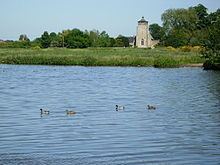Population 226 (2011) | Sovereign state United Kingdom District St Edmundsbury | |
 | ||
St peter great livermere bury st edmunds
Great Livermere is a village and civil parish in the St Edmundsbury district of Suffolk in eastern England. Located around four miles north-east of the boroughs largest town Bury St Edmunds. Great Livermere also has a village hall located six miles from Bury St Edmunds, where meetings and other functions are often held here for the village. Great Livermere has a small population of 226, according to 2011 census; there are 103 males and 123 females accounted for. As seen from the population graph, the population of the village has fluctuated rapidly from 1850 to 1950 the population decreased rapidly however since the 1950s the population has steadily risen.
Contents
- St peter great livermere bury st edmunds
- Map of Great Livermere Bury Saint Edmunds UK
- History
- Literature
- Statistics
- Occupations of males and females
- Economy
- Transport
- References
Map of Great Livermere, Bury Saint Edmunds, UK
History
The name Livermere means the lake where rushes grow from the pre-7th century Old England, this was first recorded in 907 AD making it one of the earliest to survive. Rushes were also used for domestic purposes such as roofing, flooring and heating. In 1887 the village was described as "a village and a parish in the Thingoe district, Suffolk. The church of St Peter is a 12th century thatched church comprising of 1,549 acres." The church is open every day containing wall paintings, a three-decker pulpit and one of the finest organs in the area. The church of St Peter also comprises other interest such as the grave of William Sakings, Falconer to Charles l, Charles ll, and James ll.
Literature
The fictitious location of Castringham Hall was based upon the Rectory at Great Livermere. Castringham Hall was a location in the short ghost story The Ash Tree by M.R. James published in Ghost Stories of an Antiquary in 1904. From the age of three (1865) until 1909 James's home, if not always his residence, was at the Rectory in Great Livermere inspiring the location for this supernatural story.
Statistics
Religion within Great Livermere is predominantly Christian according to the office for National statistics, there are 135 Christians, 70 of which have no religion, while the remaining population are unaccounted for. According to other figures from Neighborhood statistics, within Great Livermere marital and civil partnership status demonstrate 49 people are single, 95 are married, 6 separated, 23 widowed and 17 divorced. In terms of health care within Great Livermere, 45.6% have very good health, 28.3% have good health, 19.9% have fair health, 4.4% bad health, leaving only 1.8% with very bad health. This demonstrates the majority of the population have very good health in comparison to a small fraction with very bad health, conveying a sense of a good health care sector.
Occupations of males and females
As reported from the Vision of Britain census report in 1881, it is clear from the graph below that there is significant divide between occupations of males and females within Great Livermere. The graph demonstrates twice as many females than males within the domestic offices and services industry, in comparison to a ratio of 39:1 males in the agricultural industry.The agricultural sector is clearly marked on the graph seen below as the most predominant livelihood according to census data from the Vision of Britain report. In addition, it is only males that engage with animals e.g. game-keeping whereas females are accounted for no engagement. According to the Vision of Britain census report the ratio of males to females in the furniture, housing and decorating sector is 5:0 also showing no accounts of females. Further more women are the only sex to engage in working with dress e.g.tailoring demonstrating the comparison between sexes at this time in terms of occupations. A clear divide is seen in patriarchal norms within Great Livermere and the roles carried out between sexes as demonstrated from the 1881 graph below. In recent years as seen from the Office for National statistics census reports from 2011 show the majority of industry is manufacturing alongside health and social care activities. This shows a shift from the dominated agricultural sector as reported from 1881 census reports to a more modern day industry such as production and retail trade, although as Great Livermere is a small countryside village farming still occurs as a way of life.
Economy
All usual residents aged 16–74 account for 165 of the population of Great Livermere in 2011. Census data for 2011 states
In terms of housing within the Village of Great Livermere it is evident from the Office for National Statistics 2011 census report that the most predominant type of housing are bungalows. Other statistics show 35 live in detached, 61 in semi detached, 100 living in bungalows, and the remaining are in either apartments or mobile homes. This shows the majority of Great Livermere village are small bungalow housing perhaps catering for a more elderly population.
Transport
In terms of transport within Great Livermere, Suffolk it is evident from the Office for National statistics that cars and vans are the most common mode of transport. Census data from 2011 shows 82 people accounting for car and van use for travelling to work, in comparison to only 4 using a coach or bus. This clearly demonstrates poor public transport in the countryside area of Great Livermere as the majority work from home rather than commute outside of the town, leaving the remaining on foot and on bicycles.
